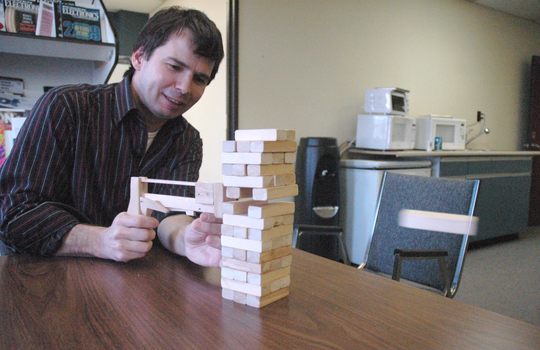

|
The game of Jenga was possibly designed to be a more contemplative and strategic game. But sliding those blocks out carefully without knocking over the stack is just entirely too fiddly a task to perform. I figured it would be much more fun to just be able to shoot the blocks out with some sort of pistol.
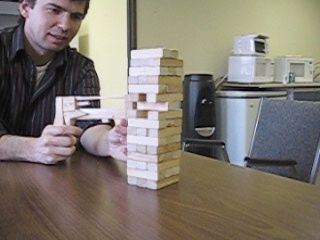
The animation at left was extracted from a video shot at 60 frames per second. It takes three frames, or about one twentieth of a second, from the point that the trigger is released to the Jenga block clearing the stack.
As a precaution, I'm pulling the pistol back immediately after the shot, to avoid
having the stack fall on the pistol's bolt.
Though if you look carefully, you can see that one of the blocks did
briefly get caught on the bolt as it came down.
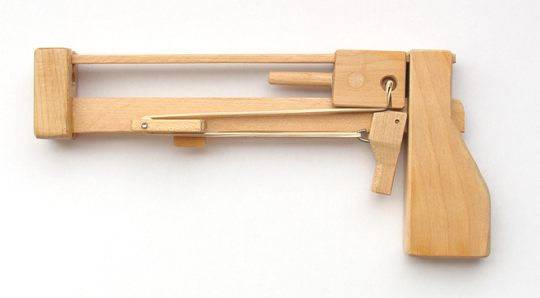 The pistol works by hurling a wooden captive bolt forward inside the pistol, powered
by rubber bands. The bolt has a
pin on the front, which protrudes out of the muzzle of the gun by about 2 cm at most.
This is enough to transfer the momentum of the bolt to the Jenga block in front of the
gun, not unlike how the game of croquet works.
The pistol works by hurling a wooden captive bolt forward inside the pistol, powered
by rubber bands. The bolt has a
pin on the front, which protrudes out of the muzzle of the gun by about 2 cm at most.
This is enough to transfer the momentum of the bolt to the Jenga block in front of the
gun, not unlike how the game of croquet works.
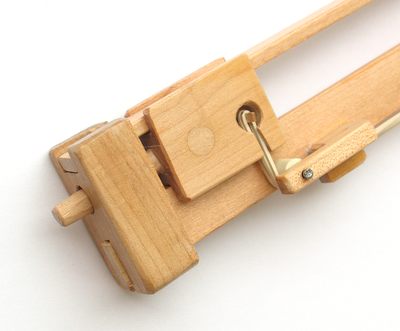 I actually designed the pistol so that the rubber band pulls the bolt back again
from its front most position after impact. The main
reason for this is that if I need to make a shot where I shoot out the sole supporting
member of the Jenga stack, that the bolt withdraws a little bit after impact to get out
of the way of the Jenga stack coming down to fill the gap. With a bit of practice, this
maneuver turns out pretty easy to pull off, without collapsing the stack.
I actually designed the pistol so that the rubber band pulls the bolt back again
from its front most position after impact. The main
reason for this is that if I need to make a shot where I shoot out the sole supporting
member of the Jenga stack, that the bolt withdraws a little bit after impact to get out
of the way of the Jenga stack coming down to fill the gap. With a bit of practice, this
maneuver turns out pretty easy to pull off, without collapsing the stack.
 Other than the rubber band and pulley, the bolt and trigger are the only moving parts
of the gun. The bolt has this little keyhole-like cavity cut into it to hook
the rubber band into. I was perhaps being exceedingly clever in doing it this way, but it's
the only way that I could think of that would allow easy replacement of the rubber bands,
and allow the rubber bands to pull the bolt forward, and then back a bit at the end of its stroke.
Other than the rubber band and pulley, the bolt and trigger are the only moving parts
of the gun. The bolt has this little keyhole-like cavity cut into it to hook
the rubber band into. I was perhaps being exceedingly clever in doing it this way, but it's
the only way that I could think of that would allow easy replacement of the rubber bands,
and allow the rubber bands to pull the bolt forward, and then back a bit at the end of its stroke.
 The trigger piece is two pieces of wood glued together. It has a hook for holding the ends of
the rubber bands. This also serves to pull the trigger up against the bolt from the
rubber band tension.
The trigger piece is two pieces of wood glued together. It has a hook for holding the ends of
the rubber bands. This also serves to pull the trigger up against the bolt from the
rubber band tension.
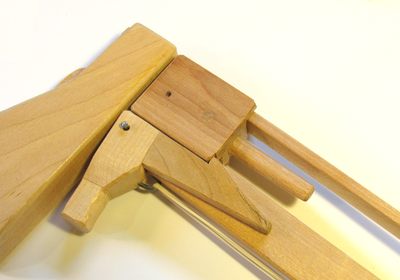 When the bolt is pulled back, it automatically hooks onto the trigger. I actually carved a very
slight hook shaped incline into the corner of the bolt where the hook catches onto it,
to make the gun less likely to trigger accidentally.
Cocking the gun is a simple matter of pulling the block all the way back.
When the bolt is pulled back, it automatically hooks onto the trigger. I actually carved a very
slight hook shaped incline into the corner of the bolt where the hook catches onto it,
to make the gun less likely to trigger accidentally.
Cocking the gun is a simple matter of pulling the block all the way back.
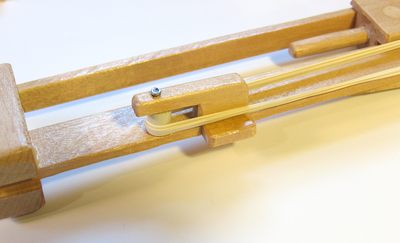 The other little tricky bit is the pulley. There's a little wooden block glued to the rails
(facing the camera in the shot at left) to keep the rubber band from moving too far sideways on the
roller. Without this block, the rubber bands were prone to get stuck between the roller and the piece
of wood holding it. I elimnated this pulley for Jenga pistol version 3
The other little tricky bit is the pulley. There's a little wooden block glued to the rails
(facing the camera in the shot at left) to keep the rubber band from moving too far sideways on the
roller. Without this block, the rubber bands were prone to get stuck between the roller and the piece
of wood holding it. I elimnated this pulley for Jenga pistol version 3
I varnished all the moving parts, and put a few drops of oil on the pieces the bolt slides against
to let the bolt move more freely.
I originally designed the gun to use just one rubber band, but with two, it shoots
harder, which is more fun. It's enough to get the bolt going to about 12 meters per second, and
accelerate the impacted Jenga block to about 6 meters per second.

Buy plans for Jenga pistol verison 3 |
My experiments selling Jenga pistols
Michael Schultheiss's jenga pistol